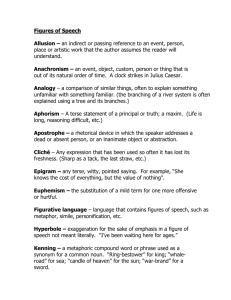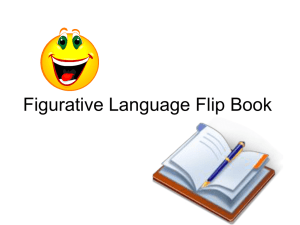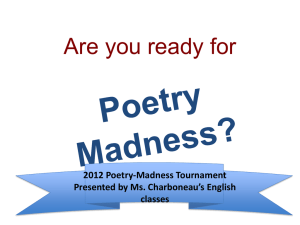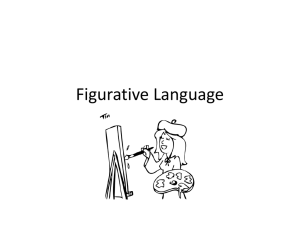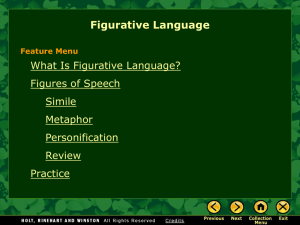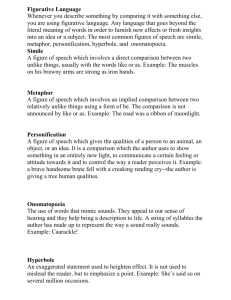(`Hints on Three Poems by Vernon Scannell`) which
advertisement
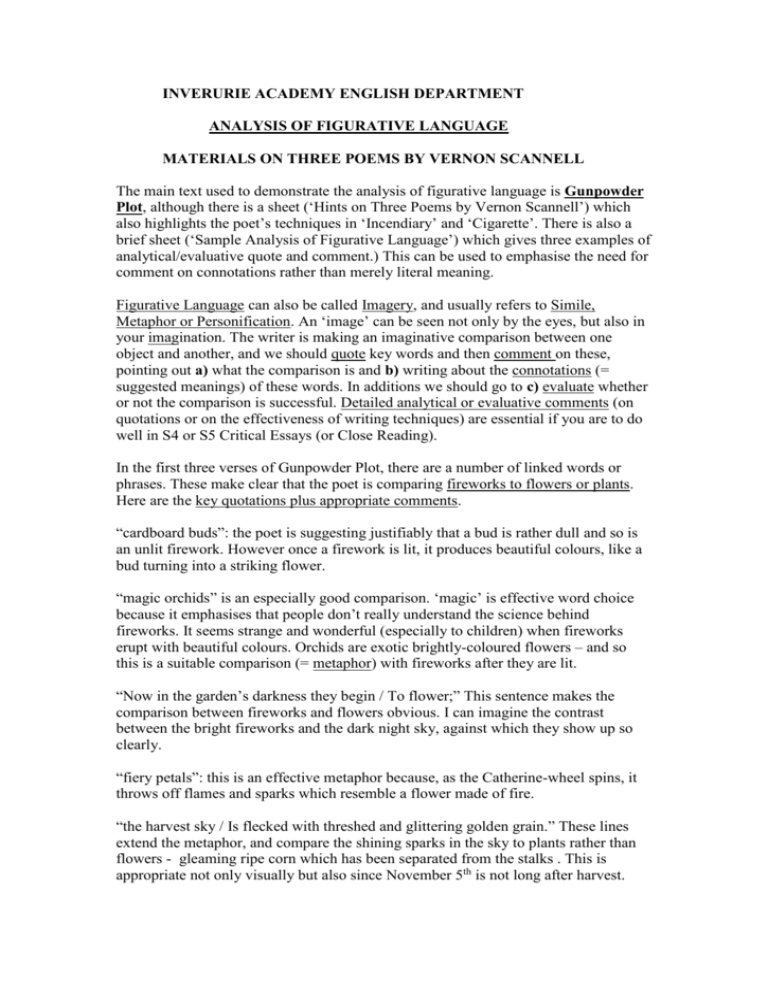
INVERURIE ACADEMY ENGLISH DEPARTMENT ANALYSIS OF FIGURATIVE LANGUAGE MATERIALS ON THREE POEMS BY VERNON SCANNELL The main text used to demonstrate the analysis of figurative language is Gunpowder Plot, although there is a sheet (‘Hints on Three Poems by Vernon Scannell’) which also highlights the poet’s techniques in ‘Incendiary’ and ‘Cigarette’. There is also a brief sheet (‘Sample Analysis of Figurative Language’) which gives three examples of analytical/evaluative quote and comment.) This can be used to emphasise the need for comment on connotations rather than merely literal meaning. Figurative Language can also be called Imagery, and usually refers to Simile, Metaphor or Personification. An ‘image’ can be seen not only by the eyes, but also in your imagination. The writer is making an imaginative comparison between one object and another, and we should quote key words and then comment on these, pointing out a) what the comparison is and b) writing about the connotations (= suggested meanings) of these words. In additions we should go to c) evaluate whether or not the comparison is successful. Detailed analytical or evaluative comments (on quotations or on the effectiveness of writing techniques) are essential if you are to do well in S4 or S5 Critical Essays (or Close Reading). In the first three verses of Gunpowder Plot, there are a number of linked words or phrases. These make clear that the poet is comparing fireworks to flowers or plants. Here are the key quotations plus appropriate comments. “cardboard buds”: the poet is suggesting justifiably that a bud is rather dull and so is an unlit firework. However once a firework is lit, it produces beautiful colours, like a bud turning into a striking flower. “magic orchids” is an especially good comparison. ‘magic’ is effective word choice because it emphasises that people don’t really understand the science behind fireworks. It seems strange and wonderful (especially to children) when fireworks erupt with beautiful colours. Orchids are exotic brightly-coloured flowers – and so this is a suitable comparison (= metaphor) with fireworks after they are lit. “Now in the garden’s darkness they begin / To flower;” This sentence makes the comparison between fireworks and flowers obvious. I can imagine the contrast between the bright fireworks and the dark night sky, against which they show up so clearly. “fiery petals”: this is an effective metaphor because, as the Catherine-wheel spins, it throws off flames and sparks which resemble a flower made of fire. “the harvest sky / Is flecked with threshed and glittering golden grain.” These lines extend the metaphor, and compare the shining sparks in the sky to plants rather than flowers - gleaming ripe corn which has been separated from the stalks . This is appropriate not only visually but also since November 5th is not long after harvest. Later in the poem, the explosion of a “banger”, and the smell of gunpowder, forces the narrator to relive his traumatic war memories. These memories overcoming him are compared to: “the lurking past / Lurching to my side.” Comment on this comparison (= personification). Where has the past been “lurking”? Can you visualise the creature that is attacking him – what is it like? Is this a good comparison and why? Comment also on the following examples of figurative language: “the guy, / Absurdly human phoenix, is again / Gulped by greedy flames:” “a ten-year memory to walk / Unhindered now;” “the banshee howl of mortar”; “the torn earth’s grunts”. (You may have to look up the meaning of certain words before you make proper analytical comments on connotations and the effectiveness of these quotations.) HINTS ON THREE POEMS BY VERNON SCANNELL (QUOTE + TECHNIQUE + COMMENT ON CONNOTATIONS OR EFFECT) PERSONAL REACTION TO AND OPINION OF TEXT. Gunpowder Plot Structure – before firework party, build-up to banger explosion, traumatic war memories, ending. Enjambement. Ten syllable lines; four-line verses, rhyming ABAB etc. Basic iambic pentameter rhythm (= short stress on first syllable / longer stress on second syllable). Which important words are stressed? (By emphatic position or unusual stress.) Imagery and word choice associated with firework/flowers extended metaphor. Onomatopoeia. Sound effects. Immediacy. Disturbing hints: Catherine-wheel; guy burning; shocked with blast; war memories. ‘the lurking past/ lurching to my side’ – personification of subconscious memories as a monster. Haunted by his experiences. Puzzle of ‘talk..died’ and “corpse’s sons”. Sad irony of last line – ignorance of older nephew. Three meanings of the title. Theme of poem. Incendiary Structure – small poem; big impact! First long eleven-line sentence, split after seven lines. Second five-line sentence (beginning with ‘And’) leads to concluding two lines. Climax. Basic iambic pentameter rhythm, ten-syllable lines. Any important words stressed? Unusual para-rhyme AABB etc (same consonants but different vowels) = weak because the topic is so unpleasant and sad. Strong final couplet to make a clear statement about what would have avoided such destruction. Contrasts throughout. Size of boy and size of fire; Size of protest and size of kiss. Theme – child cruelty; vandalism. Tone – shock, pity, sad irony. Word choice – good descriptive details. Imagery – simile, personification. Hyperbole (= exaggeration). Cigarette Structure – three stages: young boy fascinated by his uncle smoking; nine-year old boy’s first cigarette; adult viewpoint on smoking. Basic iambic pentameter rhythm. Rhyme scheme ABAB etc. Word choice and imagery. Personification. Personality of cigarette? Metaphor ‘Thin….curling’. Contrast. ‘Veil-dance’ His feelings and thoughts. Ambiguity (= double meaning) e.g. ‘falling’. Formal/informal language plus effect. Alliteration. Metaphor ‘paces’. Climax. Ominous euphemism. Conclusion. Effect now and reason for smoking. SAMPLE ANALYSIS OF FIGURATIVE LANGUAGE (Remember also to add comments making clear your own opinion of aspects of the poem and the extent to which the poem is well-written = Evaluation) a) Literal Meaning of the words quoted b) Comment on Connotations (= suggested meaning) and/or the Effectiveness of Techniques ( i.e. are they appropriate? Suitable? Any good?) ‘magic orchids’ ‘magic’ is effective word choice because it emphasises that people don’t really understand the science behind fireworks. It seems strange and wonderful when fireworks erupt with beautiful colours. Orchids are exotic brightly-coloured flowers – and so a suitable comparison (= metaphor) with fireworks after they are lit. ‘the darkest of all destinations’ The alliteration emphasises the seriousness of this phrase. It is a euphemism for death and a very effective expression (= metaphor) because it sounds gloomy and ominous. ‘a whole menagerie / of flame-fanged tigers roaring hungrily’ The fire is so huge that it is compared to not one tiger but many. The connotations of the expression (= personification – which is a form of metaphor) are that the loudly crackling fire is brightly-coloured, dangerous and destructive – and the comparison with tigers is very appropriate. ‘flame-fanged’ uses alliteration and metaphor so we can visualise the sharp-edged flames greedily ripping into and destroying the farm buildings, just like a tiger’s canine teeth would rip into the flesh of a prey.

